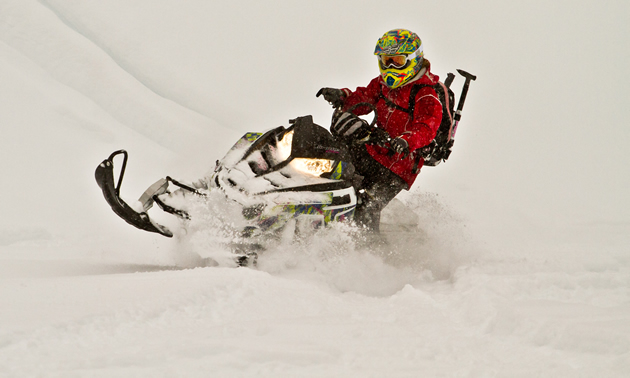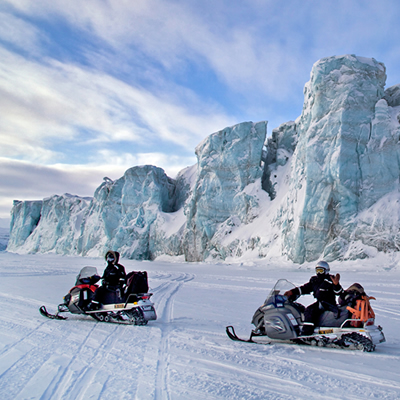SnoRiders contributor Trish Drinkle has written two fantastic articles about riding with your wife or significant other that are awesome, insightful and full of useful tips. Recently, I had a pretty wicked experience that involved a day of shredding with three female friends who had come up to Whistler, B.C., for a visit from Washington.
I had ridden with two of the three previously and the mountain sledding world is a small one, so I had heard of the third girl—who was, of course, a friend-of-a-friend connection. This gave me a good idea of what their riding ability was—I say was because by the end of one day, they had improved so much it was astounding. I also had an idea of what their comfort zones, physical abilities and all those other things were.
The day turned out to be a lot of fun for all of us—not only did we get in some great riding but the girls had made some major strides forward in their riding abilities, which not only had them excited but I must say had me pretty stoked as well. We started out with a half day of fun riding, showing them around one of my favourite zones. This got them warmed up and allowed me to see where they were at, riding-wise. In the afternoon, when one of them asked for a simple tip, it turned into a three-hour lesson on how to ride “wrong foot forward,” which all three girls not only figured out but put to good use by the time the darkness descended.
It was not only fun hanging out and helping Kendra Kinghorn, Stephanie Santeford and Kimberly Patrick learn a new skill set but also pretty awesome to know that I was helping a few girls advance their riding—which was going to allow them to ride with more confidence and go more places. Working with the girls, I learned a few things that help make their and your day better.
Here is what I learned:
Do not go out with an agenda for yourself. The day is all about the girls and making sure that they have fun and learn. If you decide to assert your own riding plans into the day while trying to teach them, things are not necessarily going to go your way; this is one of the leading factors in people losing their patience. It is their day—remember that, and you are more than halfway there.
Expectations, where you hope to be and where you are at the end of the day, can be two different things. Don’t think that she is going to be an expert rider in one session. Think of each time as a small step and when they are all put together, she will become a confident and strong rider in no time.
Instructing, coaching or teaching women riders is not that different than guys or anyone else, but remember that, in general, women don't have the strength or weight that us boys do. Remember to set their sled up for that. Softer suspension and bar position—it might sound like small things but the small things can make a world of difference at the end of the day.
Riding zones need to be conducive to learning and the rider. If you are teaching them to spin a tight turn directly above a nasty creek or some other sketchy obstacle, you are probably not going to be successful. If you are practising or teaching sidehilling, choose a mellow roll in the terrain that has a nice turnaround area on each end as well as a good run into it.
Work on one thing at a time so as not to overload your pupil. Assess their abilities and think about breaking everything down in steps—whether it is just learning basic riding position or moving into more advanced techniques. Always work up; with the three girls I rode with, their next step was to learn “wrong foot forward.” This helped them learn edge control and the technique is used in many situations, like sidehilling as well as sharp turns. When done properly, it not only gives you more control of your sled but also helps reduce fatigue, which, in the long run, will mean longer and more challenging riding in the future.
Break everything down. Explain what they should be doing with their feet, hips, shoulders and hands, as well as when and why they should be using the throttle. Get them to practise the same move over and over until they are proficient enough to start moving it into more difficult terrain. Women often need more of an explanation—they seem to be more analytical and they don’t have the same misplaced sense of pride that us guys often do when it comes to asking for more information.
Technique, technique, technique—this cannot be stated enough. Too often girls will try to muscle things around because they don’t have the body weight that men do—they stick their butts out, pulling their chest to the bars. This is not helping them but it is often taught and encouraged. With proper technique, women can do all the things needed to control and throw a sled around but it needs to be taught and reiterated until they have it dialled in (this should go for anyone).
Encouragement is a big factor with anyone who is learning but women and men tend to hear things differently now and then. This doesn’t mean you have to be a sensitive guy—but smiling, telling them they are doing great, letting them know that getting stuck or rolling the sled is a good thing and being civil and not a caveman can go a long way.
Getting your sled stuck happens to everyone. Heck, the best riders in the world probably get stuck more than anyone else because they are always trying something new and pushing themselves. Never get mad because someone gets stuck; you do this once and, as Trish Drinkle said in one of her points, she will remember it for a long time. Let them know that getting stuck and rolling the sled is a good thing; help them get unstuck so that they are not wearing themselves out and teach them the easiest ways to get their snowmobiles out of trees and holes (most women are pretty independent and once taught they won’t need your help too often).
Understand your own personality. Not everyone is cut out to instruct and if you lack patience or just generally don’t enjoy standing around helping others learn how to improve or if you want your riding days to always be game-on charging, then it’s possible that you just are not meant to be teaching. A bad coach can turn someone off from the sport and it is a common thing heard from many women—they don’t enjoy sledding because the guys teaching them did it wrong or lacked the patience and personality for it.
Tips and techniques
1. Set the sled up for her. Soften the suspension, make sure the handlebars fit and are comfortable (the bars may need to be cut down and a shorter riser installed).
2. Start with the basics. Make sure her stance on the sled is relaxed yet ready. Almost all sports involve a basic “power stance,” standing tall with a slight bend in the knees, straight back, arms out with a slight bend in the elbow, head/neck straight up and looking forward.
3. Breathe. Many people don’t realize it but they hold their breath when they are trying hard. Breathing will help keep you relaxed and smooth.
4. Look ahead. Don’t be looking at your hands, the front bumper or the skis. You should be looking where you want to go. When you are in a right turn, you should already be looking towards your next move—whether it be a left turn sidehill, jump, whatever. This keeps you prepared and ready for anything that will be coming instead of being surprised.
5. Throttle control is important. A lot of girls (and guys) are prone to grabbing the throttle and keeping it in one spot or gradually pressing more and more until they are going too fast and losing control. Almost everything—turning, carving and sidehilling—is easier if you are constantly on and off the throttle. Constant braapping will help to keep the front end of the sled light and the ski(s) lifted and easier to control.
6. Brake control is important, not just for safety but also for controlling the sled in many different situations, like downhill carving and sidehilling. Learn to ride with at least your index finger on the brake lever all the time. That way you will be ready to use it when needed.
7. Counter-steering is one of the first basic manoeuvres used to flip your sled around. It involves turning the skis in the opposite direction of the way you want to turn or set the sled on edge. If you want to tip the sled to the right, then turn the skis to the left. This causes the tails to dig in and helps raise one side of the sled off the snow. A weight shift in the opposite direction from where you're steering combined with a quick hit on the throttle will have you tipping the sled over more easily.
8. Wrong foot forward is an important skill to have in your bag of tricks. Once you have learned it, you will be shocked at how often you will be using the technique. It not only will give you more control than riding with both your feet on one running board, but it will also help you save energy because it sets your body up so you are using your weight to hold the sled over and not as much muscle. There are four things that go into getting the sled on edge using the wrong foot forward technique: shift your weight onto your “wrong" foot, do a quick hit of the throttle, pull on the bars as you shift your weight over and add a touch of counter-steer. Try to do this all at the same time while practising on the flats and then move it gradually onto a sidehill or into a sharp turn once you start getting a feel for it.
9. Of course, watching videos is always fun and a great way to spend the time that you’re not on the sled—but instead of just sitting there being entertained, try to analyze what the riders are doing. Use the Pause and Slow Motion buttons to see what the riders are doing with their feet, hands, body positions, etc., and how it affects the sled’s movements and reactions. Gradually you will find yourself being able to break things down faster as well as apply it to your riding.
10. Small steps are the way to go when learning. Teaching in a somewhat set order will help as a rider can build on the last skill they worked on—there is a certain order to the learning curve and mixing it up too much will just make things more difficult. For example, if someone hasn’t learned counter-steering or knows somewhat how to carve, teaching them to sidehill wrong foot forward might be getting a little ahead of yourself.
11. Make sure everyone is having FUN!
Also see Sledding with your spouse and Through the mind of a She Braaper by Trish Drinkle.







